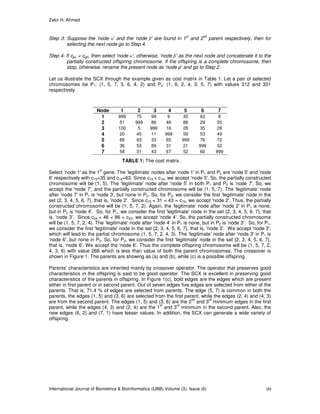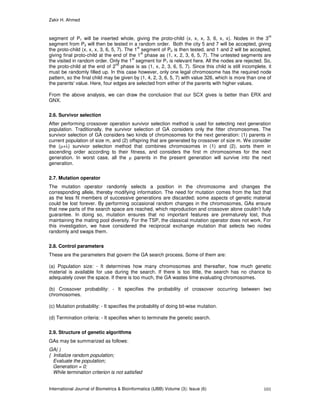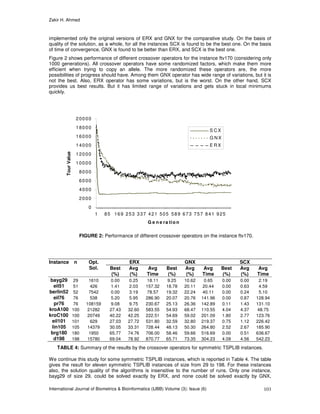This paper introduces a new crossover operator, Sequential Constructive Crossover (SCX), for genetic algorithms that provides high-quality solutions to the Traveling Salesman Problem (TSP). The SCX operator outperforms existing operators such as Edge Recombination Crossover (ERX) and Generalized N-Point Crossover (GNX) in generating offspring by leveraging better edges and improving the quality of solutions. The study includes a detailed computational experiment comparing the efficiency of SCX against other crossover methods on benchmark TSP instances.
![Zakir H. Ahmed
International Journal of Biometrics & Bioinformatics (IJBB) Volume (3): Issue (6) 96
Genetic Algorithm for the Traveling Salesman Problem using
Sequential Constructive Crossover Operator
Zakir H. Ahmed zhahmed@gmail.com
Department of Computer Science,
Al-Imam Muhammad Ibn Saud Islamic University,
P.O. Box No. 5701, Riyadh-11432
Kingdom of Saudi Arabia
Abstract
This paper develops a new crossover operator, Sequential Constructive crossover
(SCX), for a genetic algorithm that generates high quality solutions to the Traveling
Salesman Problem (TSP). The sequential constructive crossover operator
constructs an offspring from a pair of parents using better edges on the basis of their
values that may be present in the parents' structure maintaining the sequence of
nodes in the parent chromosomes. The efficiency of the SCX is compared as
against some existing crossover operators; namely, edge recombination crossover
(ERX) and generalized N-point crossover (GNX) for some benchmark TSPLIB
instances. Experimental results show that the new crossover operator is better than
the ERX and GNX.
Keywords: Traveling salesman problem, NP-complete, Genetic algorithm, Sequential constructive crossover.
1. INTRODUCTION
The Traveling Salesman problem (TSP) is one of the benchmark and old problems in Computer
Science and Operations Research. It can be stated as:
A network with ‘n’ nodes (or cities), with 'node 1' as ‘headquarters’ and a travel cost (or distance, or
travel time etc.,) matrix C= [cij] of order n associated with ordered node pairs (i, j) is given. The
problem is to find a least cost Hamiltonian cycle.
On the basis of the structure of the cost matrix, the TSPs are classified into two groups – symmetric
and asymmetric. The TSP is symmetric if cij = cji, ∀ i, j and asymmetric otherwise. For an n-city
asymmetric TSP, there are )!1( −n possible solutions, one or more of which gives the minimum cost.
For an n-city symmetric TSP, there are
2
)!1( −n
possible solutions along with their reverse cyclic
permutations having the same total cost. In either case the number of solutions becomes extremely
large for even moderately large n so that an exhaustive search is impracticable.
There are mainly three reasons why TSP has been attracted the attention of many researcher’s and
remains an active research area. First, a large number of real-world problems can be modeled by
TSP. Second, it was proved to be NP-Complete problem [1]. Third, NP-Complete problems are
intractable in the sense that no one has found any really efficient way of solving them for large](https://image.slidesharecdn.com/ijbb-41-160207153012/85/Genetic-Algorithm-for-the-Traveling-Salesman-Problem-using-Sequential-Constructive-Crossover-Operator-1-320.jpg)
![Zakir H. Ahmed
International Journal of Biometrics & Bioinformatics (IJBB) Volume (3): Issue (6) 97
problem size. Also, NP-complete problems are known to be more or less equivalent to each other; if
one knew how to solve one of them one could solve the lot.
The TSP finds application in a variety of situations such as automatic drilling of printed circuit boards
and threading of scan cells in a testable VLSI circuit [2], X-ray crystallography [3], etc.
The methods that provide the exact optimal solution to the problem are called exact methods. An implicit
way of solving the TSP is simply to list all the feasible solutions, evaluate their objective function values
and pick out the best. However it is obvious that this “exhaustive search” is grossly inefficient and
impracticable because of vast number of possible solutions to the TSP even for problem of moderate
size. Since practical applications require solving larger problems, hence emphasis has shifted from
the aim of finding exactly optimal solutions to TSP, to the aim of getting, heuristically, ‘good solutions’
in reasonable time and ‘establishing the degree of goodness’. Genetic algorithm (GA) is one of the
best heuristic algorithms that have been used widely to solve the TSP instances.
Since the crossover operator plays a vital role in GA, so many crossover operators have been
proposed for the TSP. Goldberg and Lingle [4] defined an operator called PMX (partially mapped
crossover), which used two crossover points. The section between these points defines an
interchange mapping. This PMX operator was the first attempt to apply GAs to the TSP, in which they
found near-optimal solutions to a well-known 33-node problem. The OX (ordered crossover) operator
developed by Davis [5] builds offspring by choosing a subsequence of a tour from one parent and
preserving the relative order of nodes from the other parent. Another crossover operator, named CX
(cycle crossover) operator was proposed by Oliver et al. [6], where offspring are built in such a way
that each node (and its position) comes from one of the parents. Whitley et al. [7] proposed edge
recombination crossover (ERX) operator that uses an ‘edge map’ to construct an offspring that inherits
as much information as possible from the parent structures. This edge map stores all the connections
from the two parents that lead into and out of a node. A crossover operator based on the conventional
N-point crossover operator, named as generalized N-point crossover (GNX), was proposed by
Radcliffe and Surry [8]. Poona and Carter [9] developed a tie break crossover (TBX), which was then
modified by Choi et al. [10] by combining PMX and TBX operators. Moon et al. [11] proposed a new
crossover operator named Moon Crossover (MX), which mimics the changes of the moon such as
waxing moon → half moon → gibbous → full moon. As reported, performance of MX operator and OX
operator is almost same, but OX never reached an optimal solution for all trials.
In this paper, a new crossover operator named sequential constructive crossover (SCX) is developed and
accordingly a genetic algorithm based on SCX is developed for solving the TSP.
This paper is organized as follows: Section 2 develops a genetic algorithm based on SCX for the TSP.
Section 3 describes computational experiments for three crossover operators. Finally, Section 4 presents
comments and concluding remarks.
2. GENETIC ALGORITHMS
Genetic algorithms (GAs) are based essentially on mimicking the survival of the fittest among the
species generated by random changes in the gene-structure of the chromosomes in the evolutionary
biology [12]. In order to solve any real life problem by GA, two main requirements are to be satisfied:
(a) a string can represent a solution of the solution space, and
(b) an objective function and hence a fitness function which measures the goodness of a solution can
be constructed / defined.
A simple GA works by randomly generating an initial population of strings, which is referred as gene
pool and then applying (possibly three) operators to create new, and hopefully, better populations as
successive generations. The first operator is reproduction where strings are copied to the next
generation with some probability based on their objective function value. The second operator is
crossover where randomly selected pairs of strings are mated, creating new strings. The third
operator, mutation, is the occasional random alteration of the value at a string position. The crossover
operator together with reproduction is the most powerful process in the GA search. Mutation](https://image.slidesharecdn.com/ijbb-41-160207153012/85/Genetic-Algorithm-for-the-Traveling-Salesman-Problem-using-Sequential-Constructive-Crossover-Operator-2-320.jpg)
![Zakir H. Ahmed
International Journal of Biometrics & Bioinformatics (IJBB) Volume (3): Issue (6) 98
diversifies the search space and protects from loss of genetic material that can be caused by
reproduction and crossover. So, the probability of applying mutation is set very low, whereas the
probability of crossover is set very high.
2.1. Genetic coding
To apply GA for any optimization problem, one has to think a way for encoding solutions as feasible
chromosomes so that the crossovers of feasible chromosomes result in feasible chromosomes. The
techniques for encoding solutions vary by problem and, involve a certain amount of art. For the TSP,
solution is typically represented by chromosome of length as the number of nodes in the problem.
Each gene of a chromosome takes a label of node such that no node can appear twice in the same
chromosome. There are mainly two representation methods for representing tour of the TSP –
adjacency representation and path representation. We consider the path representation for a tour,
which simply lists the label of nodes. For example, let {1, 2, 3, 4, 5} be the labels of nodes in a 5 node
instance, then a tour {1→ 3→4→ 2→ 5 →1} may be represented as (1, 3, 4, 2, 5).
2.2. Fitness function
The GAs are used for maximization problem. For the maximization problem the fitness function is
same as the objective function. But, for minimization problem, one way of defining a ‘fitness function’
is as
)(
1
)(
xf
xF = , where f(x) is the objective function. Since, TSP is a minimization problem; we
consider this fitness function, where f(x) calculates cost (or value) of the tour represented by a
chromosome.
2.3. Reproduction operator
In reproduction/selection process, chromosomes are copied into next generation mating pool with a
probability associated with their fitness value. By assigning to next generation a higher portion of the
highly fit chromosomes, reproduction mimics the Darwinian survival-of-the-fittest in the natural world.
In natural population, fitness is determined by a creature’s ability to survive predators, pestilence, and
other obstacles to adulthood and subsequent reproduction. In this phase no new chromosome is
produced. The commonly used reproduction operator is the proportionate reproduction operator,
where a string is selected for the mating pool with a probability proportional to its fitness value. We
have considered the stochastic remainder selection method [13] for our genetic algorithms.
2.4. Sequential constructive crossover operator (SCX)
The search of the solution space is done by creating new chromosomes from old ones. The most
important search process is crossover. Firstly, a pair of parents is randomly selected from the mating
pool. Secondly, a point, called crossover site, along their common length is randomly selected, and the
information after the crossover site of the two parent strings are swapped, thus creating two new
children. Of course, this basic crossover method does not support for the TSP.
The sequential constructive crossover (SCX) operator constructs an offspring using better edges on
the basis of their values present in the parents' structure. It also uses the better edges, which are
present neither in the parents' structure. As the ERX and GNX, the SCX does not depend only on the
parents' structure; it sometimes introduces new, but good, edges to the offspring, which are not even
present in the present population. Hence, the chances of producing a better offspring are more than
those of ERX and GNX. A preliminary version of the operator is reported as local improvement
technique [14, 15]. The algorithm for the SCX is as follows:
Step 1: - Start from 'node 1’ (i.e., current node p =1).
Step 2: - Sequentially search both of the parent chromosomes and consider the first ‘legitimate node'
(the node that is not yet visited) appeared after 'node p’ in each parent. If no 'legitimate node'
after 'node p’ is present in any of the parent, search sequentially the nodes {2, 3, …, n} and
consider the first 'legitimate' node, and go to Step 3.](https://image.slidesharecdn.com/ijbb-41-160207153012/85/Genetic-Algorithm-for-the-Traveling-Salesman-Problem-using-Sequential-Constructive-Crossover-Operator-3-320.jpg)





![Zakir H. Ahmed
International Journal of Biometrics & Bioinformatics (IJBB) Volume (3): Issue (6) 104
whereas five instances, bayg29, eil51, berlin52, eil76 and brg180, could be solved exactly, at least
once in ten runs, by SCX. Between ERX and GNX, on the basis of quality of best solution value and
average solution value, for the instances from bayg29 to lin105, ERX is found to be better; but for two
instances brg180 and d198, GNX is found to be better. For these symmetric instances also, as size of
the problem increases GNX is found to be better than ERX. On the basis of quality of the solution, for
all of these instances also, SCX is found to be the best one.
4. CONCLUSION & FUTURE WORK
We have proposed a new crossover operator named sequential constructive crossover (SCX) for a
genetic algorithm for the Traveling Salesman Problem (TSP). We presented a comparative study
among SCX, ERX and GNX for some benchmark TSPLIB instances. In terms of quality of the
solution, for the less sized instances, ERX is found to be better than GNX. But, as the size increases
GNX is found to be better than ERX. Among all the operators, experimental results show that our
proposed crossover operator (SCX) is better than the ERX and GNX, in terms of quality of solutions
as well as solution times.
In this present study, we only consider the original version of ERX and GNX. Our aim was only to
compare the quality of the solutions by different crossover operators. Our aim was not to improve the
solution quality by any of the operators. That is why; we do not use any local search technique to
improve the solution quality. We do not set high population size and do not consider parallel version of
algorithms to obtain exact solution as was done by Whitley et al. [7]. Also, we set here highest
probability of crossover to show the exact nature of crossover operators. Mutation with lowest
probability is applied just not to get stuck in local minima quickly.
it is very difficult to say that what moderate sized instance is unsolvable exactly by our crossover
operator, because, for example, the instance brg180 of size 180 could be solved exactly, at least one
in ten runs, whereas ftv38 of size 39 could not be solved within ten runs. So an incorporation of good
local search technique to the algorithm may solve exactly the other instances, which is under our
investigation.
Acknowledgements
This research was supported by Deanery of Academic Research, Al-Imam Muhammad Ibn Saud
Islamic University, Saudi Arabia vide Grant No. 280904.
5. REFERENCES
[1] C.H. Papadimitriou and K. Steglitz. “Combinatorial Optimization: Algorithms and Complexity”.
Prentice Hall of India Private Limited, India, 1997.
[2] C.P. Ravikumar. "Solving Large-scale Travelling Salesperson Problems on Parallel Machines”.
Microprocessors and Microsystems 16(3), pp. 149-158, 1992.
[3] R.G. Bland and D.F. Shallcross. "Large Travelling Salesman Problems arising form Experiments
in X-ray Crystallography: A Preliminary Report on Computation". Operations Research Letters 8,
pp. 125-128, 1989.
[4] D.E. Goldberg and R. Lingle. “Alleles, Loci and the Travelling Salesman Problem”. In J.J.
Grefenstette (ed.) Proceedings of the 1st
International Conference on Genetic Algorithms and
Their Applications. Lawrence Erlbaum Associates, Hilladale, NJ, 1985.
[5] L. Davis. “Job-shop Scheduling with Genetic Algorithms”. Proceedings of an International
Conference on Genetic Algorithms and Their Applications, pp. 136-140, 1985.](https://image.slidesharecdn.com/ijbb-41-160207153012/85/Genetic-Algorithm-for-the-Traveling-Salesman-Problem-using-Sequential-Constructive-Crossover-Operator-9-320.jpg)
![Zakir H. Ahmed
International Journal of Biometrics & Bioinformatics (IJBB) Volume (3): Issue (6) 105
[6] I.M. Oliver, D. J. Smith and J.R.C. Holland. “A Study of Permutation Crossover Operators on the
Travelling Salesman Problem”. In J.J. Grefenstette (ed.). Genetic Algorithms and Their
Applications: Proceedings of the 2nd
International Conference on Genetic Algorithms. Lawrence
Erlbaum Associates, Hilladale, NJ, 1987.
[7] D. Whitley, T. Starkweather and D. Shaner. “The Traveling Salesman and Sequence Scheduling:
Quality Solutions using Genetic Edge Recombination”. In L. Davis (Ed.) Handbook of Genetic
Algorithms. Van Nostrand Reinhold, New York, pp. 350-372, 1991.
[8] N.J. Radcliffe and P.D. Surry. “Formae and variance of fitness”. In D. Whitley and M. Vose
(Eds.) Foundations of Genetic Algorithms 3. Morgan Kaufmann, San Mateo, CA, pp. 51-72,
1995.
[9] P. Poon and J. Carter. “Genetic algorithm crossover operations for ordering applications”.
Computers and Operations Research 22, pp. 135–47, 1995.
[10] I. Choi, S. Kim and H. Kim. "A genetic algorithm with a mixed region search for the asymmetric
traveling salesman problem". Computers & Operations Research 30, pp. 773 – 786, 2003.
[11] C. Moon, J. Kim, G. Choi and Y. Seo. "An efficient genetic algorithm for the traveling salesman
problem with precedence constraints". European Journal of Operational Research 140, pp. 606-
617, 2002.
[12] D.E. Goldberg. "Genetic Algorithms in Search, Optimization, and Machine Learning". Addison-
Wesley, New York, 1989.
[13] K. Deb. “Optimization For Engineering Design: Algorithms And Examples”. Prentice Hall Of India
Pvt. Ltd., New Delhi, India, 1995.
[14] Z.H. Ahmed. "A sequential Constructive Sampling and Related approaches to Combinatorial
Optimization". PhD Thesis, Tezpur University, India, 2000.
[15] Z.H. Ahmed and S.N.N. Pandit. “The travelling salesman problem with precedence constraints”.
Opsearch 38, pp. 299-318, 2001.
[16] TSPLIB, http://www.iwr.uni-heidelberg.de/iwr/comopt/software/TSPLIB95/](https://image.slidesharecdn.com/ijbb-41-160207153012/85/Genetic-Algorithm-for-the-Traveling-Salesman-Problem-using-Sequential-Constructive-Crossover-Operator-10-320.jpg)